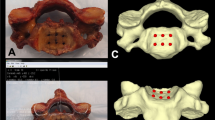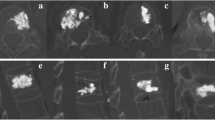Abstract
Vertebral cement augmentation can restore the stiffness and strength of a fractured vertebra and relieve chronic pain. Previous finite element analysis, biomechanical tests and clinical studies have indirectly associated new adjacent vertebral fractures following augmentation to altered loading. The aim of this repeated measures in situ biomechanical study was to determine the changes in the adjacent and augmented endplate deformation following cement augmentation of human cadaveric functional spine units (FSU) using micro-computed tomography (micro-CT). The surrounding soft tissue and posterior elements of 22 cadaveric human FSU were removed. FSU were assigned to two groups, control (n = 8) (loaded on day 1 and day 2) and augmented (n = 14) (loaded on day 1, augmented 20% cement fill, and loaded on day 2). The augmented group was further subdivided into a prophylactic augmentation group (n = 9), and vertebrae which spontaneously fractured during loading on day 1 (n = 5). The FSU were axially loaded (200, 1,000, 1,500–2,000 N) within a custom made radiolucent, saline filled loading device. At each loading step, FSUs were scanned using the micro-CT. Endplate heights were determined using custom software. No significant increase in endplate deformation following cement augmentation was noted for the adjacent endplate (P > 0.05). The deformation of the augmented endplate was significantly reduced following cement augmentation for both the prophylactic and fracture group (P < 0.05, P < 0.01, respectively). Endplate deformation of the controls showed no statistically significant differences between loading on day 1 and day 2. A linear relationship was noted between the applied compressive load and endplate deflection (R 2 = 0.58). Evidence of significant endplate deformation differences between unaugmented and augmented FSU, while evident for the augmented endplate, was not present for the adjacent endplate. This non-invasive micro-CT method may also be useful to investigate endplate failure, and parameters that predict vertebral failure.










Similar content being viewed by others
References
Ananthakrishnan D, Berven S, Deviren V, Cheng K, Lotz JC, Xu Z, Puttlitz CM (2005) The effect on anterior column loading due to different vertebral augmentation techniques. Clin Biomech 20:25–31. doi:10.1016/j.clinbiomech.2004.09.004
Baroud G, Nemes J, Heini P, Steffen T (2003) Load shift of the intervertebral disc after a vertebroplasty: a finite-element study. Eur Spine J 12:421–426. doi:10.1007/s00586-002-0512-9
Berlemann U, Ferguson SJ, Nolte LP, Heini PF (2002) Adjacent vertebral failure after vertebroplasty. A biomechanical investigation. J Bone Joint Surg Br 84:748–752. doi:10.1302/0301-620X.84B5.11841
Biggemann M, Hilweg D, Brinckmann P (1988) Prediction of the compressive strength of vertebral bodies of the lumbar spine by quantitative computed tomography. Skelet Radiol 17:264–269. doi:10.1007/BF00401809
Brinckmann P, Frobin W, Hierholzer E, Horst M (1983) Deformation of the vertebral end-plate under axial loading of the spine. Spine 8:851–856. doi:10.1097/00007632-198311000-00007
Cooper C, Atkinson EJ, Jacobsen SJ, O’Fallon WM, Melton LJIII (1993) Population-based study of survival after osteoporotic fractures. Am J Epidemiol 137:1001–1005
Cooper C, Atkinson EJ, O’Fallon WM, Melton LJIII (1992) Incidence of clinically diagnosed vertebral fractures: a population-based study in Rochester, Minnesota, 1985–1989. J Bone Miner Res 7:221–227
Coumans JV, Reinhardt MK, Lieberman IH (2003) Kyphoplasty for vertebral compression fractures: 1-year clinical outcomes from a prospective study. J Neurosurg 99:44–50
Deramond H, Mathis JM (2002) Vertebroplasty in osteoporosis. Semin Musculoskelet Radiol 6:263–268. doi:10.1055/s-2002-36724
Evans AJ, Jensen ME, Kip KE, DeNardo AJ, Lawler GJ, Negin GA, Remley KB, Boutin SM, Dunnagan SA (2003) Vertebral compression fractures: pain reduction and improvement in functional mobility after percutaneous polymethylmethacrylate vertebroplasty retrospective report of 245 cases. Radiology 226:366–372. doi:10.1148/radiol.2262010906
Fribourg D, Tang C, Sra P, Delamarter R, Bae H (2004) Incidence of subsequent vertebral fracture after kyphoplasty. Spine 29:2270–2276. doi:10.1097/01.brs.0000142469.41565.2a
Gangi A, Guth S, Imbert JP, Marin H, Dietemann JL (2003) Percutaneous vertebroplasty: indications, technique, and results. Radiographics 23:e10. doi:10.1148/rg.e10
Gluer CC, Blake G, Lu Y, Blunt BA, Jergas M, Genant HK (1995) Accurate assessment of precision errors: how to measure the reproducibility of bone densitometry techniques. Osteoporos Int 5:262–270. doi:10.1007/BF01774016
Hodler J, Peck D, Gilula LA (2003) Midterm outcome after vertebroplasty: predictive value of technical and patient-related factors. Radiology 227:662–668. doi:10.1148/radiol.2273011930
Holmes AD, Hukins DW, Freemont AJ (1993) End-plate displacement during compression of lumbar vertebra-disc-vertebra segments and the mechanism of failure. Spine 18:128–135. doi:10.1097/00007632-199301000-00019
Homminga J, Weinans H, Gowin W, Felsenberg D, Huiskes R (2001) Osteoporosis changes the amount of vertebral trabecular bone at risk of fracture but not the vertebral load distribution. Spine 26:1555–1561. doi:10.1097/00007632-200107150-00010
Hulme PA, Boyd SK, Ferguson SJ (2007) Regional variation in vertebral bone morphology and its contribution to vertebral fracture strength. Bone 41:947–957. doi:10.1016/j.bone.2007.08.019
Hulme PA, Ferguson SJ, Boyd SK (2008) Determination of vertebral endplate deformation under load using micro-computed tomography. J Biomech 41:78–85. doi:10.1016/j.jbiomech.2007.07.018
Hulme PA, Krebs J, Ferguson SJ, Berlemann U (2006) Vertebroplasty and kyphoplasty: a systematic review of 69 clinical studies. Spine 31:1983–2001. doi:10.1097/01.brs.0000229254.89952.6b
Hwang SN, Wehrli FW (2002) Subvoxel processing: a method for reducing partial volume blurring with application to in vivo MR images of trabecular bone. Magn Reson Med 47:948–957. doi:10.1002/mrm.10138
Iqbal MM (2000) Osteoporosis: epidemiology, diagnosis, and treatment. South Med J 93:2–18
Johannessen W, Vresilovic EJ, Wright AC, Elliott DM (2004) Intervertebral disc mechanics are restored following cyclic loading and unloaded recovery. Ann Biomed Eng 32:70–76. doi:10.1023/B:ABME.0000007792.19071.8c
Kayanja MM, Evans K, Milks R, Lieberman IH (2006) Adjacent level load transfer following vertebral augmentation in the cadaveric spine. Spine 31:E790–E797. doi:10.1097/01.brs.0000238690.09903.4c
Keller TS, Kosmopoulos V, Lieberman IH (2005) Vertebroplasty and kyphoplasty affect vertebral motion segment stiffness and stress distributions: a microstructural finite-element study. Spine 30:1258–1265. doi:10.1097/01.brs.0000163882.27413.01
Kobayashi K, Shimoyama K, Nakamura K, Murata K (2005) Percutaneous vertebroplasty immediately relieves pain of osteoporotic vertebral compression fractures and prevents prolonged immobilization of patients. Eur Radiol 15:360–367. doi:10.1007/s00330-004-2549-0
Komemushi A, Tanigawa N, Kariya S, Kojima H, Shomura Y, Komemushi S, Sawada S (2006) Percutaneous vertebroplasty for osteoporotic compression fracture: multivariate study of predictors of new vertebral body fracture. Cardiovasc Intervent Radiol 29:580–585. doi:10.1007/s00270-005-0138-5
Lee CK, Kim YE, Lee CS, Hong YM, Jung JM, Goel VK (2000) Impact response of the intervertebral disc in a finite-element model. Spine 25:2431–2439. doi:10.1097/00007632-200010010-00003
Liebschner MA, Rosenberg WS, Keaveny TM (2001) Effects of bone cement volume and distribution on vertebral stiffness after vertebroplasty. Spine 26:1547–1554. doi:10.1097/00007632-200107150-00009
Lin EP, Ekholm S, Hiwatashi A, Westesson PL (2004) Vertebroplasty: cement leakage into the disc increases the risk of new fracture of adjacent vertebral body. AJNR Am J Neuroradiol 25:175–180
Lindsay R, Silverman SL, Cooper C, Hanley DA, Barton I, Broy SB, Licata A, Benhamou L, Geusens P, Flowers K, Stracke H, Seeman E (2001) Risk of new vertebral fracture in the year following a fracture. JAMA 285:320–323. doi:10.1001/jama.285.3.320
Loeffel M, Heini P, Bouduban N, Burger J, Nolte LP, Kowal J (2007) Development of a computer assisted high pressure injection device for vertebroplasty. IEEE Trans Biomed Eng 54:2051–2056. doi:10.1109/TBME.2007.894964
Lu S, Xu YQ, Zhang MC, Tang X, Wang YL, Zhong SZ (2007) Biomechanical effect of vertebroplasty on the adjacent intervertebral levels using a three-dimensional finite element analysis. Chin J Traumatol 10:120–124
Lyles KW, Gold DT, Shipp KM, Pieper CF, Martinez S, Mulhausen PL (1993) Association of osteoporotic vertebral compression fractures with impaired functional status. Am J Med 94:595–601. doi:10.1016/0002-9343(93)90210-G
McMillan DW, Garbutt G, Adams MA (1996) Effect of sustained loading on the water content of intervertebral discs: implications for disc metabolism. Ann Rheum Dis 55:880–887. doi:10.1136/ard.55.12.880
Melton LJIII, Atkinson EJ, Cooper C, O’Fallon WM, Riggs BL (1999) Vertebral fractures predict subsequent fractures. Osteoporos Int 10:214–221. doi:10.1007/s001980050218
Melton LJIII, Kan SH, Frye MA, Wahner HW, O’Fallon WM, Riggs BL (1989) Epidemiology of vertebral fractures in women. Am J Epidemiol 129:1000–1011
Molloy S, Mathis JM, Belkoff SM (2003) The effect of vertebral body percentage fill on mechanical behavior during percutaneous vertebroplasty. Spine 28:1549–1554. doi:10.1097/00007632-200307150-00014
Nachemson AL (1981) Disc pressure measurements. Spine 6:93–97. doi:10.1097/00007632-198101000-00020
Peh WC, Gilula LA (2003) Percutaneous vertebroplasty: indications, contraindications, and technique. Br J Radiol 76:69–75. doi:10.1259/bjr/10254271
Polikeit A, Nolte LP, Ferguson SJ (2003) The effect of cement augmentation on the load transfer in an osteoporotic functional spinal unit—finite-element analysis. Spine 28:991–996. doi:10.1097/00007632-200305150-00006
Pollintine P, Dolan P, Tobias JH, Adams MA (2004) Intervertebral disc degeneration can lead to “stress-shielding” of the anterior vertebral body: a cause of osteoporotic vertebral fracture? Spine 29:774–782. doi:10.1097/01.BRS.0000119401.23006.D2
Race A, Broom ND, Robertson P (2000) Effect of loading rate and hydration on the mechanical properties of the disc. Spine 25:662–669. doi:10.1097/00007632-200003150-00003
Riggs BL, Melton LJIII (1995) The worldwide problem of osteoporosis: insights afforded by epidemiology. Bone 17:505S–511S. doi:10.1016/8756-3282(95)00258-4
Rohlmann A, Zander T, Bergmann G (2006) Spinal loads after osteoporotic vertebral fractures treated by vertebroplasty or kyphoplasty. Eur Spine J 15:1255–1264. doi:10.1007/s00586-005-0018-3
Silverman SL (1992) The clinical consequences of vertebral compression fracture. Bone 13(Suppl 2):S27–S31. doi:10.1016/8756-3282(92)90193-Z
Sun K, Liebschner MA (2004) Biomechanics of prophylactic vertebral reinforcement. Spine 29:1428–1435. doi:10.1097/01.BRS.0000128760.94173.90
Trout AT, Kallmes DF, Kaufmann TJ (2006) New fractures after vertebroplasty: adjacent fractures occur significantly sooner. AJNR Am J Neuroradiol 27:217–223
Truumees E, Hilibrand A, Vaccaro AR (2004) Percutaneous vertebral augmentation. Spine J 4:218–229. doi:10.1016/j.spinee.2003.08.029
Uppin AA, Hirsch JA, Centenera LV, Pfiefer BA, Pazianos AG, Choi IS (2003) Occurrence of new vertebral body fracture after percutaneous vertebroplasty in patients with osteoporosis. Radiology 226:119–124. doi:10.1148/radiol.2261011911
van Dieen JH, Kingma I, Meijer R, Hansel L, Huiskes R (2001) Stress distribution changes in bovine vertebrae just below the endplate after sustained loading. Clin Biomech 16(Suppl 1):S135–S142. doi:10.1016/S0268-0033(00)00105-4
Villarraga ML, Bellezza AJ, Harrigan TP, Cripton PA, Kurtz SM, Edidin AA (2005) The biomechanical effects of kyphoplasty on treated and adjacent nontreated vertebral bodies. J Spinal Disord Tech 18:84–91. doi:10.1097/01.bsd.0000138694.56012.ce
Wasnich RD (1996) Vertebral fracture epidemiology. Bone 18:179S–183S. doi:10.1016/8756-3282(95)00499-8
Wilcox RK (2004) The biomechanics of vertebroplasty: a review. Proc Inst Mech Eng 218:1–10. doi:10.1243/095441104322807703
Zoarski GH, Snow P, Olan WJ, Stallmeyer MJ, Dick BW, Hebel JR, De Deyne M (2002) Percutaneous vertebroplasty for osteoporotic compression fractures: quantitative prospective evaluation of long-term outcomes. J Vasc Interv Radiol 13:139–148. doi:10.1016/S1051-0443(07)61930-7
Acknowledgments
Funding for this research was provided by AOSpine, Dübendorf, Switzerland (Grant # SRN 02/105). The authors wish to thank Josh MacNeil for his assistance with micro-CT data acquisition and analysis, Urs Rohrer, Erland Mülheim and Thomas Gerber for machining the loading device, and Mario Löffel for the use of the cement injection device and associated data acquisition equipment.
Author information
Authors and Affiliations
Corresponding author
Rights and permissions
About this article
Cite this article
Hulme, P.A., Boyd, S.K., Heini, P.F. et al. Differences in endplate deformation of the adjacent and augmented vertebra following cement augmentation. Eur Spine J 18, 614–623 (2009). https://doi.org/10.1007/s00586-009-0910-3
Received:
Revised:
Accepted:
Published:
Issue Date:
DOI: https://doi.org/10.1007/s00586-009-0910-3




